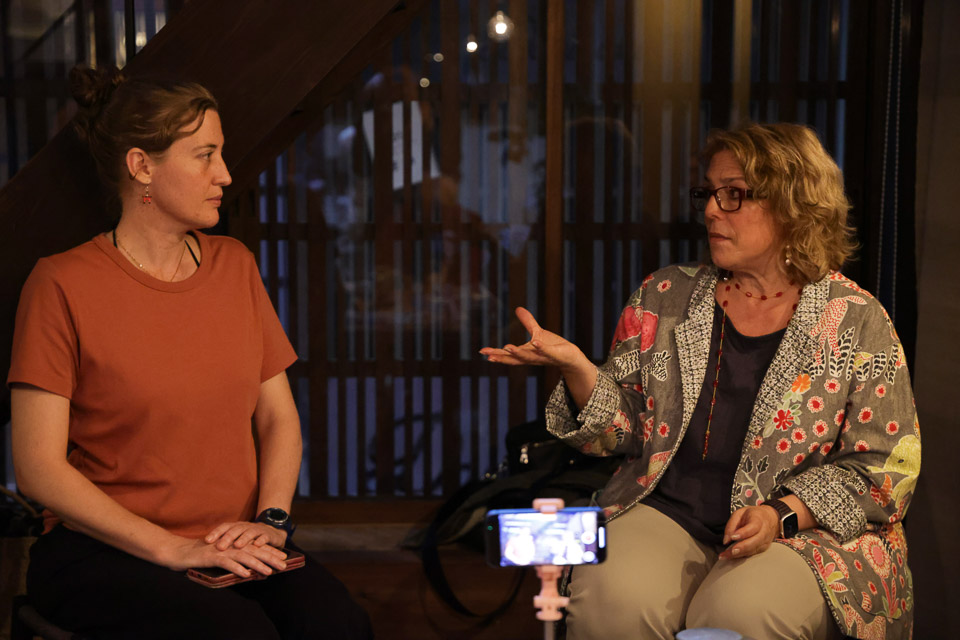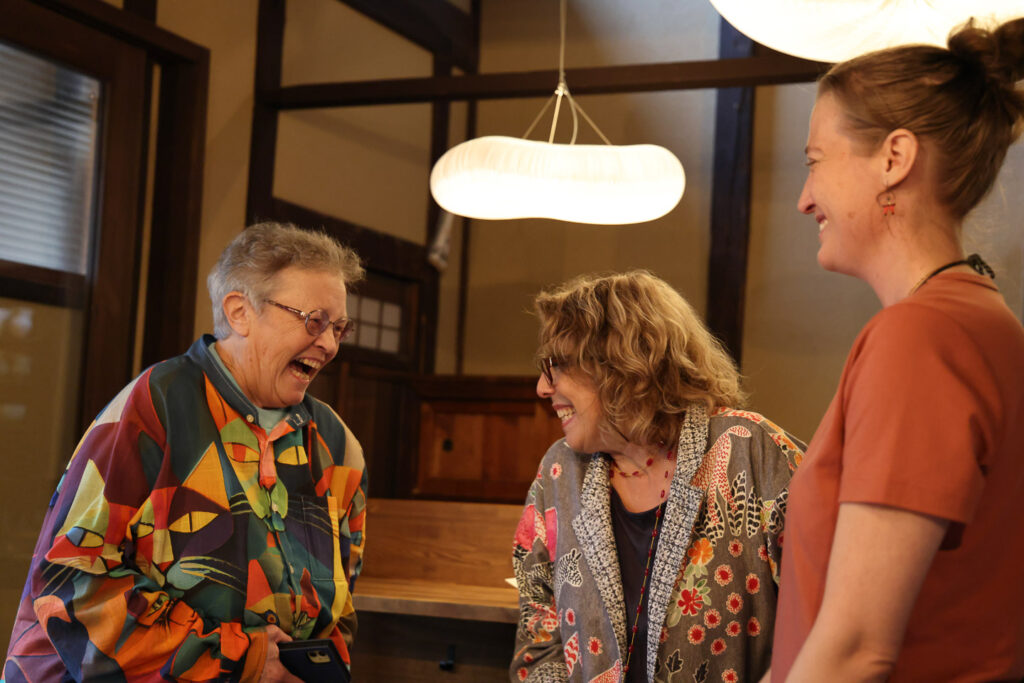At Garden Labo, Kyoto, November 17, 2024
Our valued Membership Secretary, Tina Tersini deBellegarde, came to Kyoto recently and had a launch of her most recent book (September 2024), Autumn Embers, which is set mostly in Kyoto and is the third in the mystery series, Batavia-on-the-Hudson. This series also includes previously published titles Winter Witness and Dead Man’s Leap, and has been nominated for the prestigious Agatha Award.
The launch included an interview with Felicity Tillack, and was attended by several key members of WiK as well as Tina’s cover illustrator, Elisa Tanaka, and others. (The following precis of the interview contains no direct quotes except where indicated.)

FT: What is the book about?
TD: It is the third in the series, the other two were set in the small fictitious village of Batavia-on-the-Hudson, and the plot revolves around a precious netsuke (ivory figurine) which was discovered by the widowed resident librarian/detective Bianca St. Denis, and she goes to Kyoto to return it as it was part of a valuable set. She also aims to reconnect with her son Ian, who has made his home in Kyoto, and while there she finds herself caught up in a murder mystery.
The theme is the need to find our “chosen family”, which may not necessarily be one’s birth family.
FT: What is your other history of writing?
TD: Well, I wrote journals all my life. I also wrote sone short stories. I was teaching (she was an American history and fine arts teacher in New York), and when I retired I decided to try my hand at a novel.
FT: Please explain your idea of geography/location as a character.
TB: The fictitious small town where the series is set is similar to my present situation. I feel it is important for the reader to “be there when I read”. I walk around a lot and get ideas for plots from the places and people I see.
FT: Please talk about your writing process.
TD: I think I am influenced by Anne Tyler. I base my characters on their location. And I try to write sparingly but give readers enough to base their understanding on.
FT: Can you talk about the characters in the book?
TD: Well, my main character is Bianca St. Denis, and she lives in the small town but has come from outside; there is a possibility for a fresh view. She also “helps” the local law enforcement, as the small town atmosphere, where people know each other personally, allows a breakdown of “rules and regulations”. I also want to emphasize that the characters are fictional! But I will admit that writing this has allowed me to come to terms and better understand my own son’s life in Kyoto.
FT: How did you decide on this title?
TD: Fire is a major theme in the book. Bianca is fascinated by the fire festivals she attends in Kyoto, and the last scene, where the “chosen family” and friends gather around a bonfire, is pivotal in summing up the theme of the book. I wanted to convey warmth which I feel is expressed by the term “embers”.
FT: The book has actually two locales — Kyoto and Batavia-on-the-Hudson. How did you manage that?
TD: Well, it took some juggling especially with differences in time zones.
FT: Share some other challenges in writing.
TD: It was hard to write about things close to home, for example, saying goodbye at the airport; I also learned a lot about what family is from writing.
“Make your own home, and choose your own family”.
FT: Do you do writing practice at all?
TD: Not regularly. I am very disciplined when I’m actually writing, and I appreciate being under pressure e.g. with deadlines.
FT: Do you have other books in the works?
TD: I think there are other books to come in this series. I also like short stories and am continuing to write these.
FT: Any advice for writers?
TD: Just keep trying and stretching what you think you are capable of.
A Q&A followed this interview.
Q: Why mysteries?
A: I wanted to write a lighter kind of mystery, not a hard-boiled kind. I found I could hang subplots on a mystery theme. I am very grateful for the support groups I found.
Q: Writing process?
A: I start by writing out the plot in longhand, and then go to putting Post-it notes on a white board, of which I have lots all over my house!
I also write with later books in mind — I’ll often make a character do or say something that will be taken up in the future.
Q: What about drafts?
A: I do revise and often will remove characters or incidents. I aim for tighter writing.
Q: How has having your son in Kyoto influenced this book?
A: I wanted to explore such things as the “normalcy” of life in the US vs. that of Japan, the differences in ways of being. I also used some of my own experiences to get ideas for the mother’s dialog with her son Ian.
Thanks to Felicity Tillack for the interview.
We will follow your career with interest, Tina, thanks so much for having this event and for talking to us in person!
Watch this space for a review of the book coming up!

